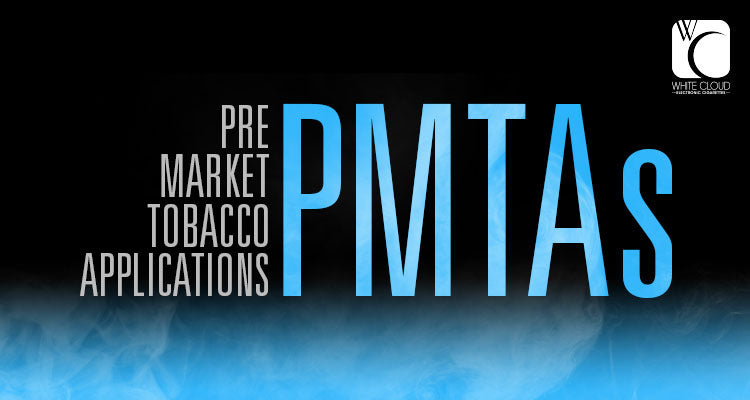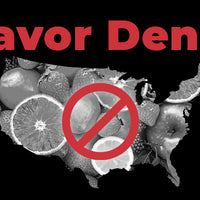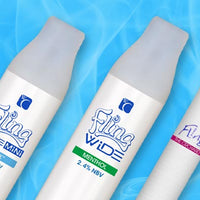It’s been a month since the vaping industry was in a scramble to finalize and submit the required premarket tobacco applications (PMTAs) by the FDA’s September 9th deadline – and we’ve got to tell you, it has taken our small PMTA team here at White Cloud just about that long to recover.
Hours upon hours, months upon months, and even years upon years have been spent just trying to understand the FDA’s vaping regulations so we could put together what turned out to be 15,000+ pages explaining why White Cloud should be here to stay.
Holy FDA PMTA, We Did It!
Before we get into all of the fun we had putting together our PMTA (yes, that might be a hint of sarcasm 😜 ), we really do want to recognize and sincerely thank our customers for being a HUGE help! We’ve spent the last 12 years sending out surveys and collecting testimonials, not only because we wanted to understand our customers’ needs and keep up with our commitment to offering quality products and the best customer service, but also because we never gave up hope that we could share them one day.
Since FDA regulations have prohibited us from publicly sharing your experiences with switching from smoking to vaping (as well as our own – remember that video we couldn’t share?), your survey responses and testimonials became the most important parts of our application (and our determination to Get. It. Done.)
So what was the PMTA process like for our small team? Well, grab your favorite White Cloud vape and get comfy because we’re about to share some of the hair-pulling, head-banging, face-palming, what-the-hell-does-the-fda-mean-by-this moments and how your survey responses and testimonials reminded us why it was all worth it.
“What the Hell Does This Even Mean?”

Oh that FDA PMTA guidance that burned into our computer screens…seriously, we can’t even tell you how long this document stayed open in our browsers, or how many times we asked ourselves and/or each other, “What the hell does this even mean?” Of course, we may have used different words…
But really, this wasn’t the first time we’ve been left scratching our heads. We’ve actually been trying to understand FDA regulations for years. Remember when we first heard about how the FDA intended to regulate e-cigs with its draft rule back in 2015? When we ended up hosting our E-Cigs DeMistified Webinar Series to seek answers from the
experts?
Or how about this episode of The Forecast when the FDA finally published its deeming regulations in 2016? As in all 499 pages worth that prompted us to seek more answers from experts and make them publicly available via our in-depth FDA PMTA Q&A Guide (still not as fun to read as it is to say).
So yeah, needless to say, the FDA’s PMTA guidance also required some guidance to understand the guidance… Nevertheless, we did the absolute best we could and are happy to share the most important highlights of our application.
Oh, That Integrated Summary

The only obvious thing about the FDA’s PMTA guidance is how much they seem to like summaries. So. Many. Summaries. There’s the recommended “well-structured summary” that goes on for pages in one section of the guidance, and the “integrated summary” described in just one line in another.
Then there’s the product description and manufacturing summary and the environmental impact summary. Oh, and let’s not forget about the “overviews” – there were at least three of those, too. Then we also had to play the guessing game of “which summary goes where” based on the FDA’s recommended table of contents that did not match the guidance.
But oh that integrated summary that threw our writer (yeah, what would be me) for a loop. Just this one line is all she (I) had to go by:
“Finally, we recommend that you provide an integrated summary discussing how permitting the marketing of the new tobacco product would be APPH from a toxicology perspective relative to any similar comparator tobacco products (when those products are used in the same manner, under similar conditions, and for the same duration and frequency).”
Errm…okay…well, after agonizing over this for much longer than it took to put together, here’s the introduction to the 30-page summary she (I) put together:
As recommended by the FDA’s industry guidance for premarket tobacco applications, this section contains an integrated summary discussing how permitting the marketing of the new tobacco product would be APPH from a toxicology perspective relative to any similar comparator tobacco products (when those products are used in the same manner, under similar circumstances, and for the same duration and frequency).
White Cloud recognizes tobacco cigarettes are a dangerous product. Smokers are far more likely than nonsmokers to be diagnosed with heart disease, lung cancer, chronic obstructive pulmonary disease (COPD) and other diseases (CDCTobaccoFree 2020). It is well known that the best way to avoid the harms of smoking is to never start, and for smokers, the best way to reduce the harms of smoking and the risk of tobacco-related disease is cessation. For decades, the goal of reducing the harm caused by smoking has therefore relied on preventing smoking initiation and promoting smoking cessation.
However, smoking is still addictive. While smoking cessation is one of the pillars of tobacco harm reduction, it has still proven difficult for many smokers. Although the prevalence of smoking in the United States (US) has been hitting all-time lows within the last decade, an estimated 34.2 million adults currently smoke cigarettes in the US (CDCTobaccoFree 2020). Cigarette smoking remains the leading cause of preventable disease in the US, accounting for more than 480,000 smoking-related deaths every year, with 41,000 resulting from secondhand smoke exposure alone and equating to about one in five deaths a year (1,300 per day). More than 16 million Americans live with a smoking-related disease, while smokers, on average, die 10 years earlier than nonsmokers.
Consequently, there is still an unmet need for alternative methods to reduce harm and smoking-related disease for Americans who continue to smoke. In an effort to accelerate the decline in smoking prevalence and smoking-related population harm, Tobacco Harm Reduction is increasingly recognized as a valuable and promising approach. Tobacco Harm Reduction is based on switching smokers to markedly less harmful tobacco and nicotine products, or MRTPs. Despite a lack of FDA-approval for smoking cessation, ENDs have played a very important role in the decline of smoking rates since being introduced to the US market more than a decade ago.
Although adult smoking rates have been at a steady decline over the last few decades due to tobacco harm control efforts, the youth smoking rate had hit an all-time high of 36.4% in 1997, which was even higher than the adult smoking rate at 24.7%. In 2007, right around the time ENDs emerged in the US, the adult smoking rate was around 19.8%, with youth smoking slightly higher at 20%. By 2017, both had significantly declined to 14% for adults and just 8.8% for youth (ALA Tobacco Trends Brief). Despite youth smoking rates falling by more than 50% between 2007 and 2017, this significant decline has been overshadowed by the rise in youth vaping.
Towards this end, White Cloud is seeking marketing orders for a range of its branded ENDs products that, based on consumer surveys and customer testimonials since its establishment in 2008, have not only been serving as effective alternatives to smoking, but are also appropriate for public health when considering the overwhelming amount of scientific evidence provided in this application.
Pretty compelling stuff for just an introduction, huh? And here’s the conclusion:
The evaluation of the effect of ENDS use on public health is not a simple matter. There are many categories of individuals to be considered, including former smokers who have converted to ENDs exclusively, ENDs users who have never smoked, those who have never used ENDS or smoked, those who are former ENDS users, current smokers and dual users, as well as youth who may begin the use of ENDS, youth who may use ENDS as a gateway to smoking, and nonusers exposed to second-hand aerosols. Whereas the use of ENDS is beneficial to adult smokers wanting to quit combustible cigarettes, the effect on youth must also be considered, as well as any toxic effects.
Upon review of the available evidence, if a considerable number of adult smokers could reduce or eliminate their consumption of combustible tobacco with the use of ENDS, the effect on public health and long term healthcare costs could be substantial. The benefits of switching to ENDS from combustible cigarettes include lower healthcare costs, lower costs of vaping as compared to smoking, economic productivity, illness reduction, and longer lifetimes. However, if underage youth begin using ENDS products or use them as a gateway to cigarette smoking, this would be an adverse effect. Taking a strong stance on prohibiting underage use of ENDS can help to alleviate this concern.
Regarding the ongoing “youth vaping epidemic”, there was an increase in the use of ENDS by youth in the last few years, but there has been a decline according to the most recent data. The use of combustible cigarettes is shrinking in both the youth and adult categories, and few adults begin using ENDS if they do not already smoke. Some studies have found that for both youth and young adults, ENDS use may increase the use of ever using combustible cigarettes; however, other studies found that the reverse is true – that e-cigarette use in youth is limited primarily to individuals who already smoke combustible cigarettes. The factors that increase the likelihood of youth to begin the use of ENDS are social environment, including the exposure to ENDS and ENDS advertisements, parent and peer use of tobacco products or ENDS, prior use of other tobacco products, perception of the harmfulness or addictiveness of ENDS, psychological aspects, and sociodemographic factors.
In terms of flavored e-liquids, evidence suggests they are beneficial to those smokers wishing to reduce or cease their use of combustible cigarettes (Bentley 2018). In fact, smokers who vaped flavored e-liquids were more likely to quit smoking than those who vaped tobacco flavors. Recent studies find that the use of ENDS increases the likelihood of smoking cessation and also the reduction of the number of cigarettes smoked per day (Friedman and Xu 2020). When compared to traditional nicotine replacement therapy, ENDS were found to be more effective and cost efficient. ENDS use is positively correlated with smoking abstinence and overall quit rates. The odds of success while using ENDS products to stop smoking are increased by using nicotine containing products vs. non-nicotine containing products, more frequent use of ENDS products, and peer support.
Overall, a review of the included literature reveals that ENDS use in general is less harmful than smoking combustible cigarettes and results in less dependency by the individual. Some current studies indicate that the health effects from ENDS use may be negligible, although further long term studies are needed. In terms of youth use liability, even if a small percentage of youth were to begin use of ENDS products, it is reasonable to assume (due to tendency factors) that if ENDS products were not available, these youth would resort to smoking combustible cigarettes. Therefore, along with ENDS youth prevention, the prevention of combustible cigarettes should also be examined by regulatory bodies to ensure a comprehensive plan that makes a clear distinction between health risks associated with ENDs use versus combusted cigarettes. Based on the available literature, there is great harm reduction to adult smokers who switch to ENDS use; therefore, when weighing the addition or reduction of harm to public health, ENDS use is a benefit to the population as a whole and White Cloud products should remain available for adult smokers in search of a less harmful alternative to combusted cigarettes.
And what was meant by “upon review of the available evidence” is that, yes, we researched and reviewed all of the available scientific studies on electronic cigarettes and included the full reports in our application to help make the case for White Cloud products (and vaping in general) as an acceptable alternative to smoking.
So You Want to Know About Our Target Market?

The FDA’s recommended PMTA outline also included a section called “Target Market for Tobacco Product”. Despite the lack of guidance in the PMTA guidance, writing this part came easy, anyway, considering White Cloud has been in business for 12 years and we know our customers very well.
As mentioned before, we’ve been collecting testimonials and conducting customer surveys for years, so we decided to not only provide the FDA with a nice little summary of our “target market” (because we know how much they like those), but also went on to provide nearly 30 pages of customer insights.
Now, without further ado, here’s a look at how those survey responses made a great case for White Cloud:
The results of the latest survey help confirm what we have known for years: White Cloud products do not appeal to youth and mostly attract older adult smokers in search of an alternative to combusted cigarettes, which is exactly our intended market. The White Cloud customer base is mostly made up of adults in the 55-65 age bracket.
In terms of smoking and vaping habits, the majority of the survey respondents indicated they are former smokers who smoked at least a pack a day for more than 30 years. They also indicated that during that time, they made several attempts to quit smoking, including the use of FDA-approved NRTs. While some did report some success with the available NRTs, an overwhelming majority indicated the available NRTs did not assist them in successfully quitting smoking. When asked if they successfully switched to vaping (as in successfully quitting smoking with the use of ENDs) and how long it took, the majority reported successfully making the switch in a month or less, while approximately 8.8% indicated they did not completely switch to vaping. The survey results also indicate that the majority of respondents initiated ENDs use as a smoking cessation aid to help better their health, while only about 4% indicated they started vaping out of curiosity. Of those who continue to vape, the majority of respondents indicated they’ve been vaping for more than 4 years. While critics may view this as taking up one habit for another, it’s important to keep in mind that if they had not switched to vaping, they would have continued to smoke; therefore, ENDs serve as an effective alternative for adult smokers who have the intention of quitting smoking but still desire the effects of nicotine. When it comes to vaping cessation, the majority of the respondents who indicated they quit vaping reported they did so because they reached their goal of becoming nicotine-free, while others indicated they quit vaping due to higher costs association with taxes, such as Pennsylvania’s 40% wholesale tax on ENDs products and the misreporting of health risks by the media.
In terms of device preferences, the survey results show the importance of offering both rechargeable and disposable prefilled systems, especially for older adult smokers looking for a simple, out-of-the-box alternative to smoking and have no interest in using advanced ENDs products or open-tank systems. It also shows the importance of offering open-tank systems for customers who prefer the customization options and cost-savings compared to prefilled systems.
In terms of nicotine use and preferences, the results show the importance of allowing customers to customize their nicotine intake by offering a selection of varying nicotine strength options. Based on the survey responses, customers tend to opt for higher nicotine strengths upon initial use of White Cloud ENDs products and shift to lower strengths after regular use. We attribute these findings to smokers looking for an alternative that offers the most authentic smoking experience possible upon initiation, and gradually stepping down their nicotine intake as they become accustomed to vaping. Offering a nicotine-free option is also important in assisting adult smokers with a goal of becoming nicotine-free, and White Cloud is one of the few ENDs retailers to offer this option.
When it comes to flavored ENDs, our survey results should serve as evidence to help prove the importance of offering flavors other than tobacco and menthol. As indicated in the results, the majority of adult smokers gravitate towards the tobacco and menthol varieties upon ENDs initiation, as this gives them the most “authentic” smoking experience. It is well-known that smoking tobacco alters the senses, including taste and smell, and that total smoking cessation helps them return back to normal. Therefore, we attribute the shift in flavor preferences from tobacco and menthol varieties upon ENDs initiation to dessert- and fruity-type flavors to adult smokers rediscovering their senses (and their enjoyment of sweet and fruity flavors that lawmakers seem to believe should only appeal to kids). Some ENDs users have even reported using their sweet flavored ENDs as an after-dinner dessert option, which tastes much better than that after-dinner cigarette.
While a little more than half of the survey respondents reported they would switch to tobacco or menthol varieties if other flavors were no longer available, the rest indicated they would look for other alternatives, including going back to smoking. When presented with the possibility of ENDs being totally removed from the market, an overwhelming majority of respondents, 1,133 to be more specific, indicated they would return to smoking, while the rest indicated they would either opt for available nicotine delivery alternatives or quit nicotine altogether.
The results of the recent survey help confirm that White Cloud products are not only reaching the hands of the intended target market, but are also serving as an effective alternative and/or smoking cessation tool. If White Cloud-branded ENDs do not receive FDA approval, it’s safe to say that, based on the survey results, the majority of White Cloud’s current customers will return to smoking. We believe this survey, in addition to the White Cloud customer testimonials we’ve collected over the years (included in the following section, should be taken into consideration when determining whether or not White Cloud-branded ENDs are appropriate for public health.
And Now We Wait…
While the approval process may take months or even years, we’re proud to report that, while we wait, and wait, and wait, successfully submitting our application on time has allowed us to continue offering the smoking alternative our customers have relied on for more than a decade. White Cloud just celebrated its 12th anniversary on October 1st, and we’re confident our PMTA will allow us to continue celebrating many, many more.





